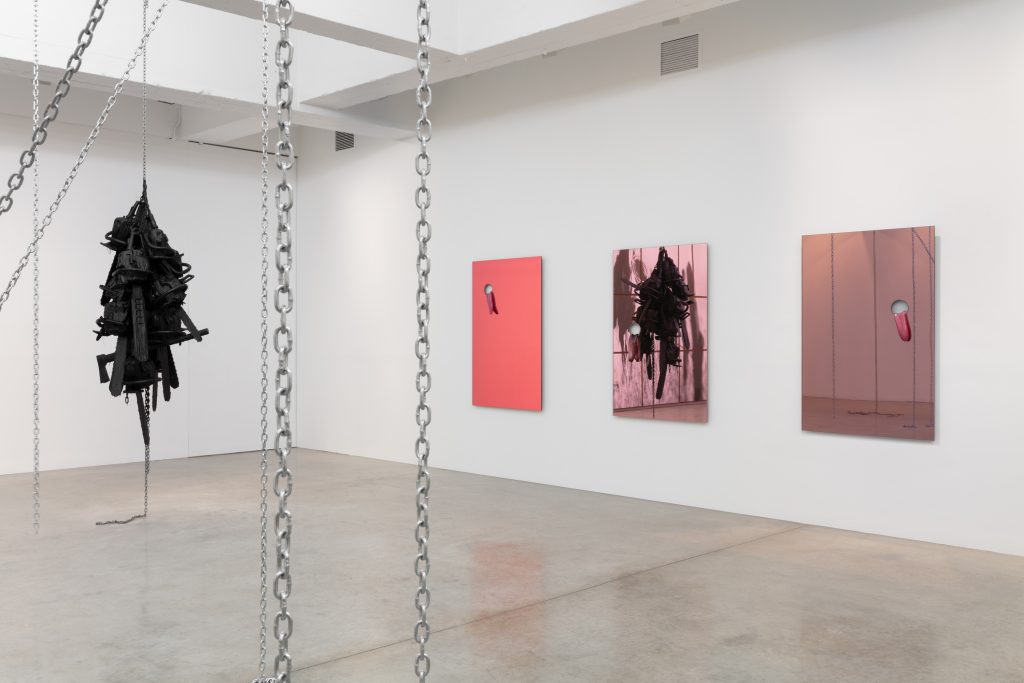Walking through “Put All Heaven in a Rage,” the new exhibition at Tanya Bonakdar Gallery in New York City of Berlin-based artist Monica Bonvicini, I felt as though I was seeing facets to familiar, everyday objects — like light fixtures and mirrors — that were always there but not always noticed or the subject of close attention.
LED Lights & Brightly Colored Mirrors
I was met first in the exhibition by a pair of sculptural pieces hanging from the ceiling, each consisting of a curved assortment of LED tubes combined with cords hanging from the lighted swoops.
Both artworks — “Rolling Down” and “Fallen,” each from 2022 — simultaneously were immediately familiar and startlingly new. Though unique in shape and construction, both maintained perceptible characters as light fixtures. That element of everyday function was still there and in the forefront rather than obscured or undone — but the sculptural drama of the curves of LED lighting combined with the repeated flow of the hanging cables substantially amplified some of the internal drama.
I saw these artworks as light fixtures dialed upwards in intensity to a dramatic extent — a fixture that was about the most intense and amplified such an implement could be.
Both here and across the exhibition, the embedded rhythms that Bonvicini was presenting were passionate, demanding, and enveloping, like an assertion of presence that jumps beyond the need for external validation or support and shines as its own aesthetic ecosystem.
Across one of the walls of the further reaches of the gallery’s downstairs space was a series of mirrors that again flourished with visual assertiveness. “Gorgeous (Ruby),” “Gorgeous (Coral Rose),” and “Gorgeous (Smoke),” all from 2024, each consisted of a colored mirror and hand blown glass. The variously shaded mirrors each had a single, perfectly rounded hole in which those blown glass pieces were placed: each looking like an extended tongue. It was as though the mirrors were sticking their tongues out at you passing by.
These straightforward constructions put on display the kind of internal processes likely always, or nearly always, present in how we put our self-images together. A mirror or anything else that gives us an image of ourselves or others is not a neutral mechanism, existing in some kind of vacuum. And Bonvicini points to that, while also cultivating a particularly free-flowing, easygoing but confrontational rhythm both here and elsewhere — although the artistic mash-ups got more vicious and physically grueling from there.


Chainsaws, an Ax, and Polyurethane
I’m thinking specifically of “Latent Combustion #2” (2015), a conjoined assortment of chainsaws — and an ax — drenched in black polyurethane and hung from the ceiling. The obviously tearing, incisive visual rhythm of the tools was thereby subsumed by waves of thick shadow.
Broadly speaking, the piece was part of Bonvicini’s spotlighted exploration of the internal character of our lived spaces and how we create and continuously fashion our identities within them.
But specifically here, she seemed to be spotlighting internal violence to these structures, sometimes perhaps ignored but still felt. You know that saws and an ax are structural, even existential tools — oriented often specifically towards destruction or dissolution, at least as a step in perhaps making something new. And the overall, visual form of this particular artwork mirrors familiar hangings like, say, a chandelier. But the piece conjures a consuming force.
On the top floor, there was also a series of artworks consisting of silkscreen and tempera on Fabriano paper that I found particularly engaging. The pieces combined snippets of text — implanted on the page with as much an aesthetic slant as a grammatical precision — with flows of (all black) color. And these accomplished something similar to the artworks slanted towards the external environment, but this time, the focus came across as more internal and experiential.
“Delight” (2024) combines the repeated phrase “born to sweet delight” at the top of the work with what I presume is the tempera, streaking down the page like rain on a windowpane, thickening towards the bottom. The visuals exposed an underpinning to the phrase and sentiments. Despite the text’s bright tone, the accompanying splatters of black nearly rip across the surface, kicking potential expectations aside while clearly outlining a new implication.

Bringing the Exhibition Together
An expectation of silence or at least of subservience — of fading into the background or side-ground as something known yet quiet — does nothing to abate churning, internal “rage” and similarly forceful emotions, desires, and subsequent impacts. And that’s on display here.
Because while subversion of expectation was consistent across this artistic showcase, so were the tone and new perspective that Bonvicini was putting atop her underpinnings. Externally, internally, and in the space where the two sides meet, she was bringing sometimes underrepresented forces to the foreground and letting them shine with glaring force.
She brought forward some of the spaces where we have the opportunity for internal and external creation and delivered a vision of relentless creative abandon. It was something free-flowing and snowballing forward maybe indefinitely! The engaging, enriching drama of reaching towards “heaven” but simultaneously upending it and crafting something fresh.
“Monica Bonvicini: Put All Heaven in a Rage” remains on view in New York through October 12.

Featured image: Monica Bonvicini; Installation view, Put All Heaven in a Rage, Tanya Bonakdar Gallery, New York, September 4 – October 12, 2024. Photo by Pierre Le Hors; Courtesy the artist and Tanya Bonakdar Gallery, New York / Los Angeles
You may also like
-
Diana Kurz at Lincoln Glenn in New York: A Review of a Shining Art Exhibition
-
Dustin Hodges at 15 Orient in New York City: An Ensnaring Exhibition at an Exciting Gallery
-
Maren Hassinger at Susan Inglett Gallery in New York: Reviewing an Uplifting Art Exhibition
-
Enzo Shalom at Bortolami in New York City: Reviewing an Entrancing Exhibition of Paintings
-
“Ben Werther: Townworld” at Amanita in New York City: Reviewing a Richly Memorable Art Exhibition
